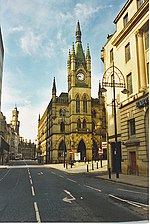The Broadway, Bradford

The Broadway is a shopping and leisure complex in the centre of Bradford, West Yorkshire, England, which opened on 5 November 2015. It was built and was operated, in its first year, by the Westfield Corporation but is owned by Ellandi. It is currently operated by Munroe K Asset Management Ltd. Buildings were demolished and roads rerouted to make way for the development in 2004; but because of continued failure to secure buy-in from enough businesses, construction did not begin in earnest until January 2014: for most of the intervening years, the site had little apart from a deep excavation, though from 2010 the area round the edge of the site was laid out as an urban park. The "hole in the ground" was very unpopular in Bradford, and at one point the site was occupied by protestors.
Excerpt from the Wikipedia article The Broadway, Bradford (License: CC BY-SA 3.0, Authors, Images).The Broadway, Bradford
Petergate Mall, Bradford Manningham
Geographical coordinates (GPS) Address Nearby Places Show on map
Geographical coordinates (GPS)
| Latitude | Longitude |
|---|---|
| N 53.7945 ° | E -1.7497 ° |
Address
Select
Petergate Mall
BD1 1AH Bradford, Manningham
England, United Kingdom
Open on Google Maps









